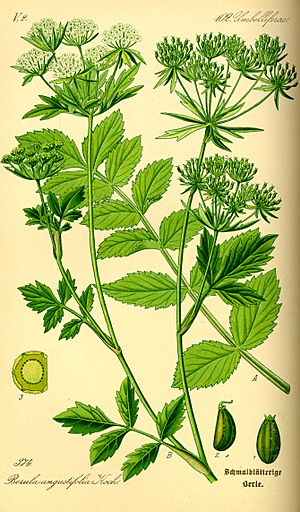Berula erecta facts for kids
Quick facts for kids Berula erecta |
|
|---|---|
 |
|
| 1885 illustration | |
| Scientific classification | |
| Synonyms | |
|
Synonymy
Apium berula Caruel
Apium sium Crantz Berla monspeliensium Bubani Berula angustifolia Greene Berula incisa (Torr.) G.N.Jones Berula orientalis Woronow ex Schischk. Berula pusilla (Nutt.) Fernald Carum sioides J.M.Black Selinum berula E.H.L.Krause Siella erecta (Huds.) Pimenov Sium erectum Huds. Sium incisum Torr. Sium orientale Soó Sium pusillum Nutt. Sium thunbergii DC. |
Berula erecta, also called lesser water-parsnip, is a plant in the carrot family. It grows to about 1 meter (3 feet) tall. You can find it in or near water. This plant is common across much of Europe, Asia, Australia, and North America.
Berula erecta has a hollow stem. Its leaves underwater look like thin threads. The leaves above the water are flatter and wider. The plant makes many small white flowers. These flowers grow in a cluster called an umbel.
Contents
About the Lesser Water-Parsnip
Berula erecta grows in wet places. It likes soils that don't drain well. You can find it in lowlands and hilly areas. It often lives in shallow water with some nutrients. In winter, the plant's stem and body go completely underwater. This plant can survive tough conditions. It grows well even with too few or too many nutrients. It also handles physical stress.
The leaves of Berula erecta have jagged edges. They are about one to two inches wide. Each plant can have around twenty white flowers. The plant can grow from one to three feet tall. Its stalk has a light ring at the bottom. This helps you tell it apart from other plants. If you crush the plant, it smells like a carrot or parsnip.
This plant naturally grows in many wet areas. These include marshes and swamps. It also lives in streams and wet meadows.
Uses of the Plant
The Zuni people are a Native American tribe. They use Berula erecta in their traditional "schumaakwe cakes." They also used it on the skin for rheumatism, which causes joint pain. A liquid made from the whole plant was used as a wash. This wash helped with rashes and athlete's foot infections.
Some other Native American groups also used Berula erecta for medicine.
Scientists have studied Berula erecta for its essential oil. This oil might have health benefits. The plant's essential oil contains special compounds called polyacetylenes. These compounds can have many good effects. For example, they can help fight tiny worms. This could be useful in farming. They also have antifungal and antibacterial properties. This means they can fight fungi and bacteria. They may also help with allergies and reduce swelling.
However, using pure polyacetylenes is tricky. They are not very stable. They can also cause allergic reactions. So, using smaller amounts from the plant's essential oil might be a better way.
After the first time it is cut, Berula erecta can grow back. It can produce flowers several more times in the same year.
Protecting the Lesser Water-Parsnip
Berula erecta is part of a special habitat in the UK. This habitat is called Purple moor grass and rush pastures. It is a type of Biodiversity Action Plan habitat.
Globally, this plant is a least-concern species. This means it is not in danger of disappearing. But in the United States, it is a threatened species. This means it is at risk. In Estonia, it is a near-threatened species. In Norway, it is an endangered species. This means it is in serious danger there.
The plant is threatened by other plants that invade its wet home. For example, watercress can grow very fast. It can take over the habitat of Berula erecta.
To help protect Berula erecta, we should keep its growing areas open. We also need to take care of its water sources. Sometimes, controlled fires can help keep the habitat healthy.
See also
 In Spanish: Berula erecta para niños
In Spanish: Berula erecta para niños

